Welcome to the exciting world of goldfish keeping! Goldfish are a popular and rewarding pet for both beginners and experienced fish keepers alike. They are known for their vibrant colors, unique personalities, and ease of care. However, taking care of goldfish requires more than just filling up a tank with water and dropping in some food. As a beginner fish keeper, it’s important to learn the basics of goldfish care to ensure that your fish stay healthy and happy. In this guide, we will cover everything you need to know about raising and taking care of goldfish, from choosing the right fish and setting up the aquarium to feeding and maintaining water quality. In this Goldfish Care Guide guide to keeping goldfish we will talk about some of the tips and tricks that experienced fish keepers have learned over the years.
Keeping fancy goldfish in a tank or aquarium can be a delightful and rewarding experience for pet lovers. However, it is important to ensure that the goldfish tank is healthy and well-maintained to ensure the health of the fish. Goldfish are cold water fish and require a clean and spacious environment to thrive. Proper maintenance of a goldfish aquarium involves understanding the aquarium nitrogen cycle and managing fish waste to keep the goldfish healthy.
Fancy goldfish are a popular choice among pet lovers due to their unique colors and shapes. However, they require a specific environment to stay healthy. One of the key components of a healthy goldfish tank is the nitrogen cycle. The nitrogen cycle is the process by which beneficial bacteria convert toxic ammonia from fish waste into less harmful nitrites and then nitrates. These nitrates can then be removed through water changes or absorbed by live plants. The nitrogen cycle is essential for maintaining a healthy balance in the goldfish tank.
To keep goldfish healthy, it is essential to manage fish waste effectively. Overfeeding goldfish can lead to excess fish waste, which can accumulate in the tank and harm the fish. It is recommended to feed goldfish small amounts of food twice a day, ensuring that they can finish the food within a few minutes. Any uneaten food should be removed promptly to prevent it from decomposing and causing water quality issues.
Regular water changes are also necessary to maintain a healthy goldfish tank. Water changes help remove excess nitrates and other harmful substances that accumulate in the tank over time. It is recommended to change approximately 25% of the water in the tank every two weeks to keep the water quality in check. However, water changes should be performed gradually, as sudden changes in water chemistry can cause stress and illness in goldfish.
In addition to managing water quality, it is also essential to ensure that the goldfish tank is spacious enough for the fish to thrive. Goldfish are active swimmers and require ample swimming space to remain healthy. The rule of thumb is to provide at least 20 gallons of water per goldfish, and additional space may be necessary for larger or more active fish. Proper filtration is also important to maintain a healthy balance of beneficial bacteria and keep the tank clean.
Despite best efforts, goldfish can still fall ill from time to time. Signs of a sick fish may include lethargy, loss of appetite, abnormal swimming behavior, or visible signs of disease. If a goldfish appears sick, it is essential to isolate the fish and seek veterinary care promptly. Early intervention can help prevent the spread of disease and increase the chances of a full recovery.
History of goldfish
Goldfish were introduced to North America in the 1850s and quickly grew in popularity in the United States. People began to breed goldfish for their bright colors and different shapes. By the 1620s, goldfish were highly valued in southern Europe for their metallic scales, which were thought to bring good luck and fortune. Married men would give their wives a goldfish on their first anniversary, in hopes of prosperity in the years to come. Selective breeding of goldfish began during the Tang dynasty and was established by the Song dynasty. These goldfish had natural mutations that caused them to be yellow instead of silver. During the Ming dynasty, goldfish were bred indoors, allowing for the selection of mutations that couldn’t survive in ponds. The first occurrence of a tailless goldfish was recorded in the Ming dynasty. Goldfish were introduced to Japan in 1603, and later to Portugal and other parts of Europe
How to choose the right goldfish
When it comes to choosing the right goldfish, there are several factors to consider to ensure that you bring home a healthy and happy fish. First, you should consider the size of the tank you have or are willing to purchase. Goldfish Care Guide for Different types of goldfish have different requirements when it comes to tank size, so it’s important to choose a goldfish species that will fit comfortably in your tank. For example, common goldfish can grow up to a foot long and require a large tank or pond, while fancy goldfish such as the Oranda or Ryukin can grow up to 8 inches and do well in smaller tanks.
Another factor to consider is the temperament of the goldfish. Some goldfish are more docile and social, while others are more aggressive and territorial. If you plan on keeping multiple goldfish in the same tank, it’s important to choose fish that will get along well with each other to prevent fighting and stress.
You should also consider the color and appearance of the goldfish. Goldfish come in a wide range of colors and patterns, from solid orange to black and white spotted. Choose a goldfish that you find aesthetically pleasing and fits your personal preferences.
Lastly, make sure to choose a goldfish that is healthy and free from any signs of illness or disease. Look for a fish with clear eyes, smooth skin, and a healthy appetite. Avoid goldfish that appear lethargic, have discolored patches or sores, or exhibit any other unusual behavior.
By considering these factors when choosing the right goldfish, you can ensure that you bring home a healthy and happy fish that will thrive in your aquarium.
Different Types of goldfish
Common Goldfish –
These are the classic goldfish, typically orange or red in color, and can grow up to a foot long. They are social and do well in groups, but require a large tank or pond to accommodate their size.
Black Telescope –

As the name suggests, this goldfish has a black coloration and a protruding eye shape. They are a hardy fish that do well in cold water and make great companions for other fancy goldfish.
Bubble Eye –
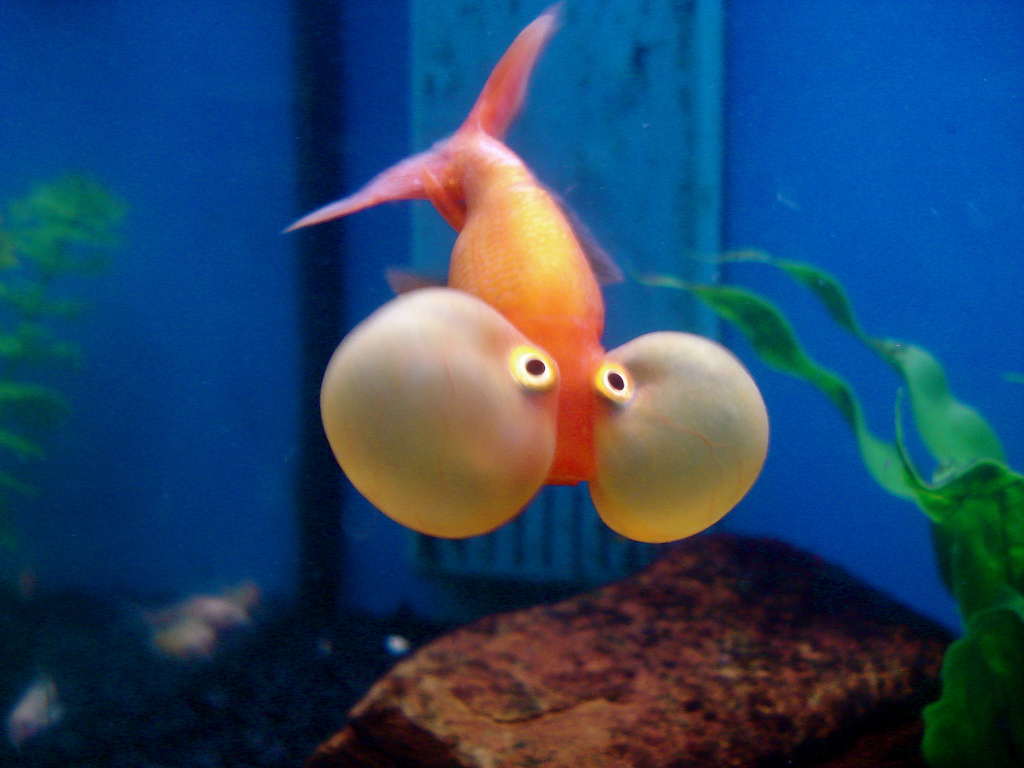
This goldfish is known for its unique appearance, with fluid-filled sacs under each eye that give it a “bubble” look. They are a delicate fish that require gentle handling and are prone to injury due to their eye sacs.
Celestial Eye –

This goldfish has upward-facing eyes that appear to look towards the sky, giving it a unique and charming appearance. They are a delicate fish that require a well-maintained aquarium and gentle handling.
Comet –
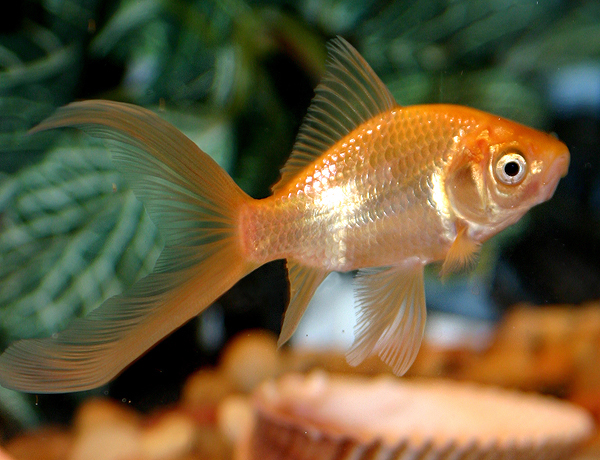
These goldfish are similar in appearance to the common goldfish, but have a longer tail and are more streamlined. They are a hardy fish that do well in both indoor and outdoor ponds.
Fantail –
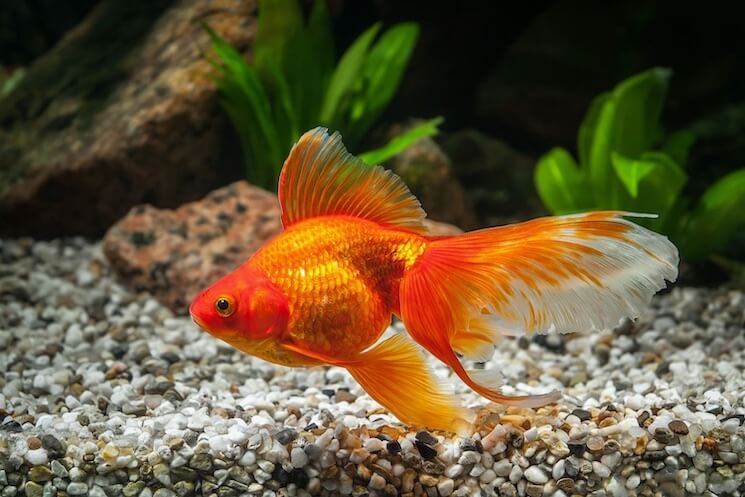
This goldfish has a rounded body and a split tail fin, giving it a fan-like appearance. They are a popular choice for aquariums and require a well-maintained tank to thrive.
Lionhead –

This goldfish has a distinctive “hood” on its head, giving it a lion-like appearance. They are a delicate fish that require a well-maintained tank and gentle handling.
Pearlscale –

This goldfish has a bumpy texture on its scales, giving it a unique appearance. They are a delicate fish that require a well-maintained aquarium and gentle handling.
Oranda –
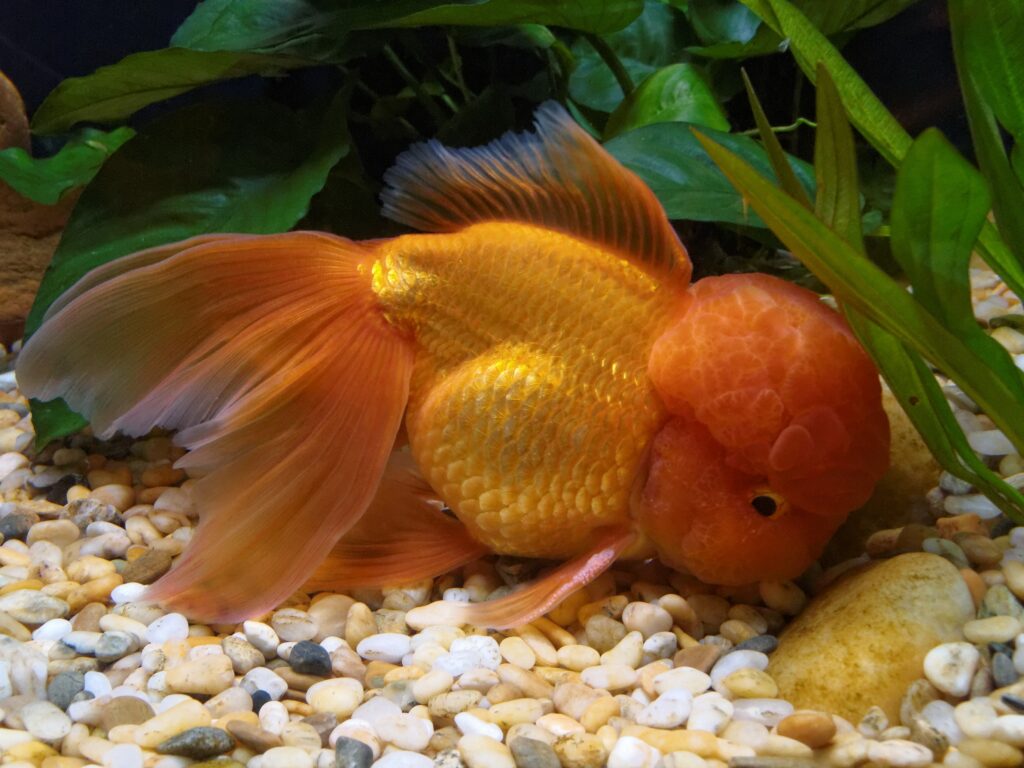
This goldfish has a distinctive “wen” or head growth, giving it a unique and charming appearance. They are a hardy fish that do well in indoor aquariums and outdoor ponds.
Pompom –
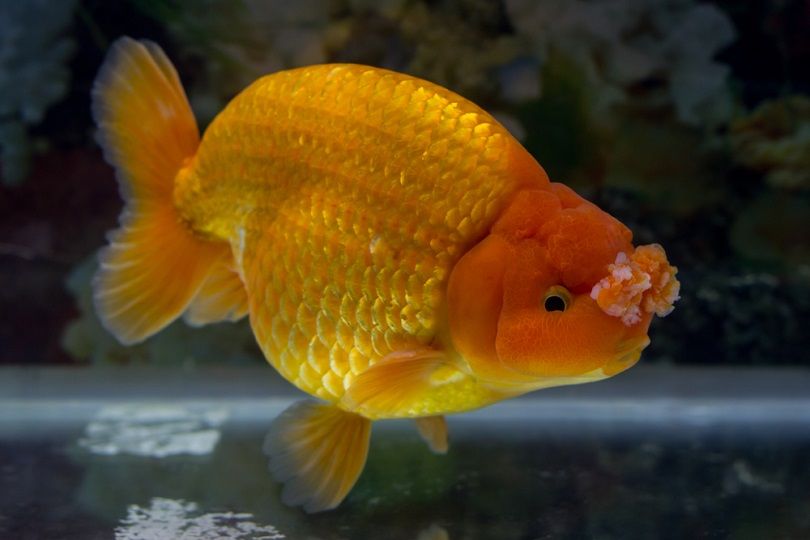
This goldfish has a distinctive “pompom” growth on its nose, giving it a unique and charming appearance. They are a delicate fish that require a well-maintained aquarium and gentle handling.
Ryukin –
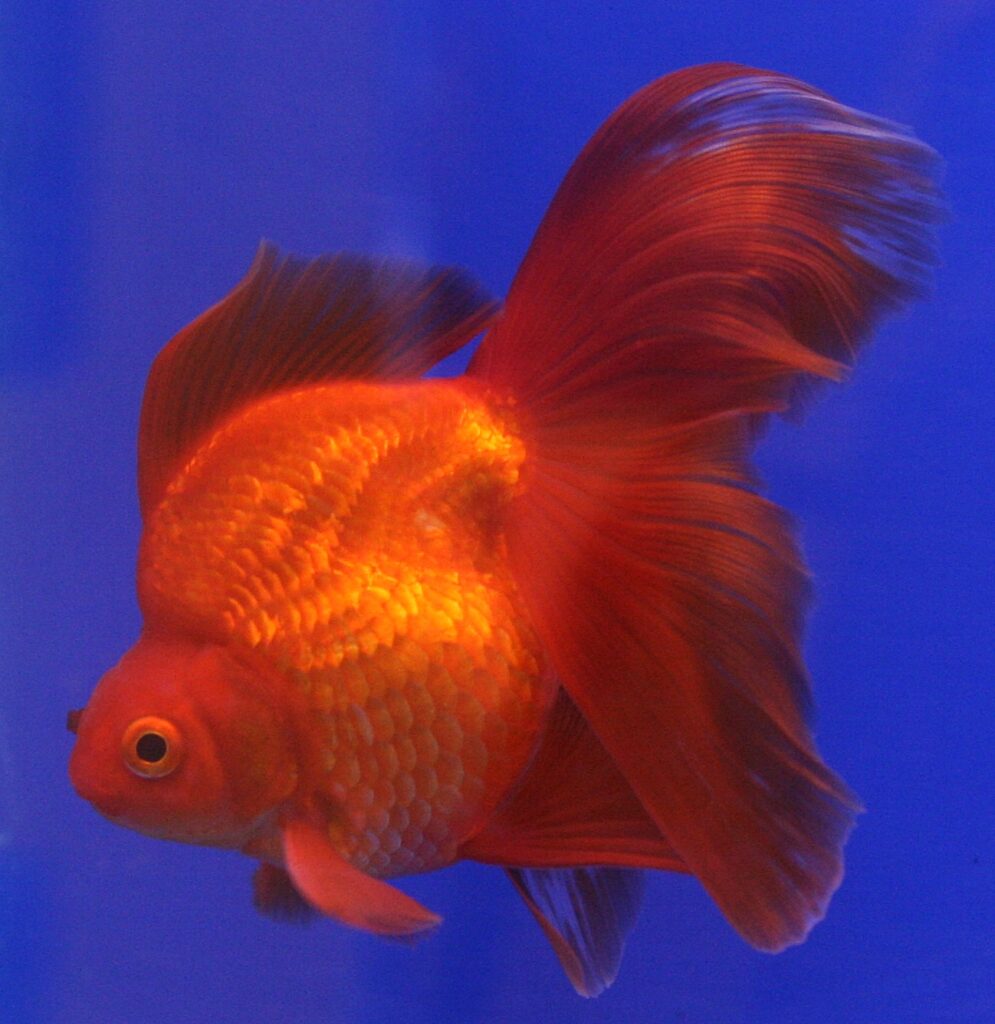
This goldfish has a deep, round body and a distinctive hump on its back. They are a hardy fish that do well in both indoor and outdoor ponds.
Shubunkin –
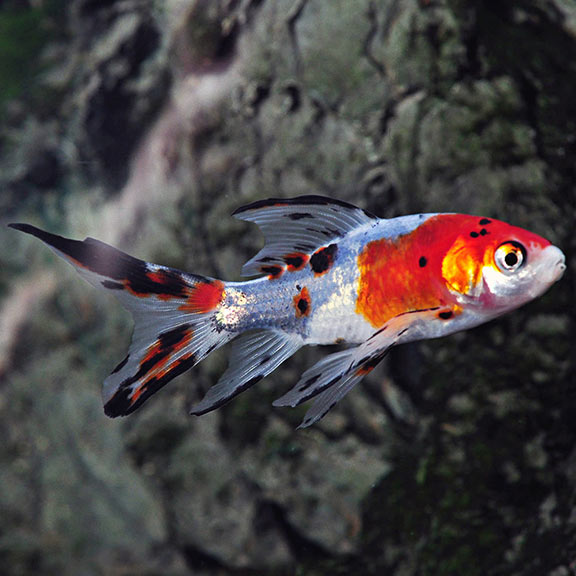
These goldfish have a calico-like coloration with a mix of orange, black, and blue scales. They are a hardy fish that do well in both indoor and outdoor ponds.
Veiltail –

This goldfish has a long, flowing tail fin that gives it a graceful appearance. They are a popular choice for aquariums and require a well-maintained tank to thrive.
Butterfly Tail –

This goldfish has a split tail fin that resembles butterfly wings, giving it a unique and charming appearance. They are a delicate fish that require a well-maintained aquarium and gentle handling.
Meteor Goldfish –
This goldfish has a distinctively metallic sheen to its scales, giving it a unique and striking appearance. They are a hardy fish that do well in both indoor and outdoor ponds.
Lionchu –
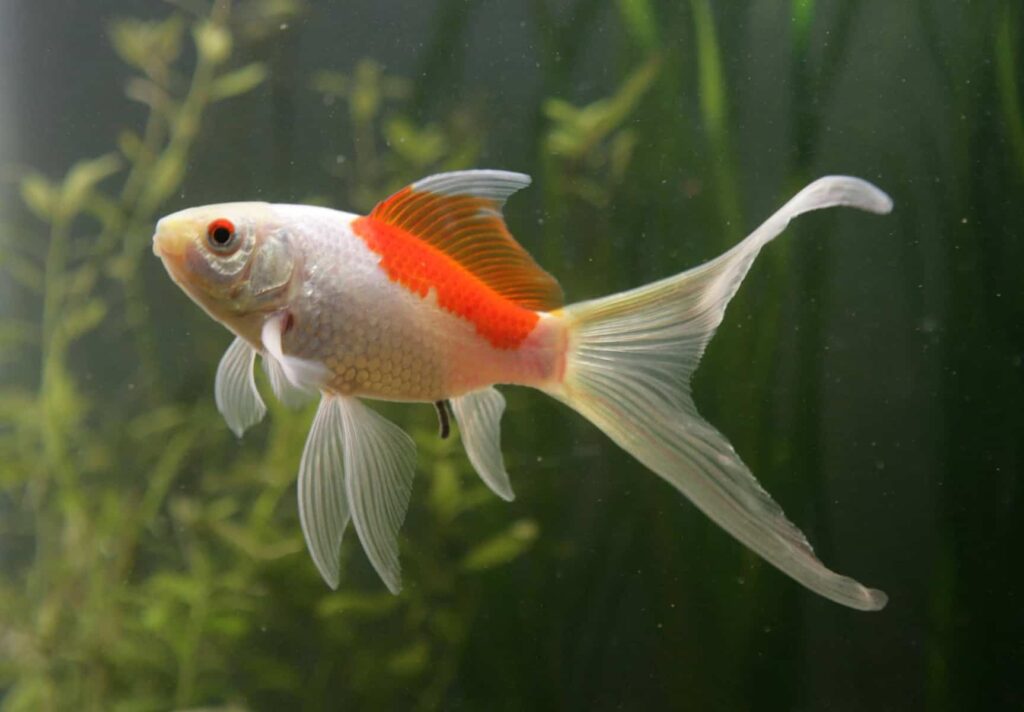
This goldfish is a crossbreed between a lionhead and a ranchu, resulting in a fish with a lion-like hood and a rounded body. They are a delicate fish that require a well-maintained aquarium and gentle handling.
Egg-Fish Goldfish –
These goldfish have a unique, egg-shaped body that sets them apart from other goldfish. They are a delicate fish that require a well-maintained aquarium and gentle handling.
Shukin –
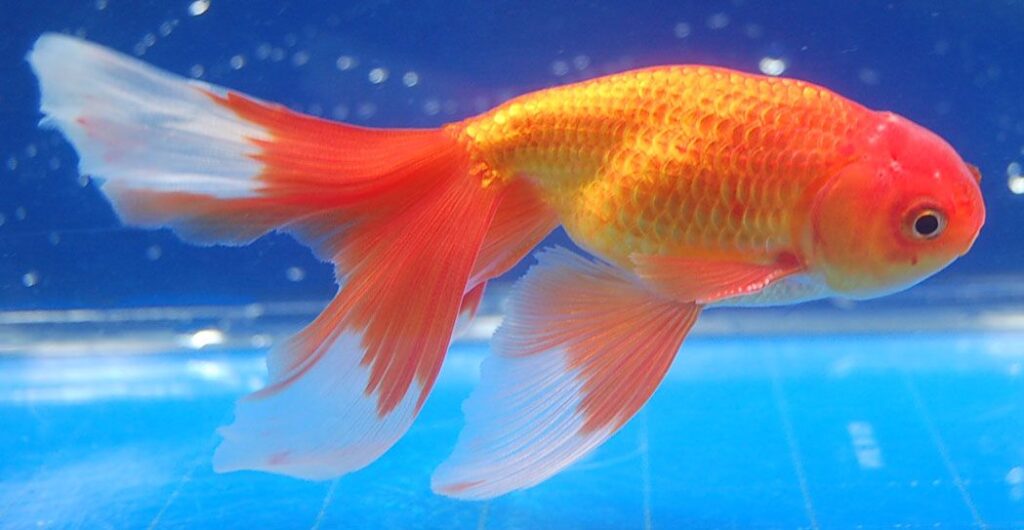
This goldfish has a rounded body and a distinctive “wen” or head growth, giving it a unique and charming
Goldfish Care Guide
How to set up a goldfish tank
Setting up an aquarium for your goldfish is an important step in providing them with a healthy and happy home. Here are some key considerations to keep in mind when setting up your goldfish tank.
Tank size and shape: Goldfish are active and social fish that require plenty of space to swim and explore. As a general rule, it’s recommended to provide at least 20 gallons of water per goldfish. For example, if you have two goldfish, you’ll need a tank that’s at least 40 gallons in size. Keep in mind that goldfish can grow quite large, so it’s important to plan ahead and choose a tank size that can accommodate their adult size. In terms of shape, rectangular tanks are best as they provide more surface area for oxygen exchange than other shapes.
Filter and cycling: A good filtration system is essential for maintaining clean water in your goldfish tank. Look for a filter that’s appropriate for the size of your tank and has a good flow rate to keep the water moving and circulating. It’s also important to cycle your tank before adding your goldfish. Cycling refers to the process of establishing beneficial bacteria in your tank that help break down harmful waste products. To cycle your tank, add a source of ammonia (such as fish food) and test the water regularly until you see a drop in ammonia levels and a rise in nitrite levels. This process can take several weeks, so be patient and monitor your tank closely during this time.
Temperature: Goldfish are coldwater fish and prefer a temperature range of 65-72°F. Avoid placing your tank in direct sunlight or near a heat source as this can cause the water temperature to fluctuate. Use a thermometer to monitor the temperature regularly and adjust the heater as needed to maintain a consistent temperature.
Decorations: Goldfish enjoy having plenty of hiding places and areas to explore in their tank. Provide a variety of decorations such as plants, rocks, and driftwood to create a stimulating and natural environment for your fish. Avoid decorations with sharp edges or small openings that could injure your goldfish. It’s also important to clean and maintain your decorations regularly to prevent the buildup of harmful bacteria.
In summary, setting up an aquarium for your goldfish involves choosing an appropriately sized tank, selecting a good filtration system, cycling the tank before adding fish, maintaining a consistent temperature, and providing plenty of stimulating decorations. By following these guidelines, you can create a healthy and happy home for your goldfish to thrive in.
How to feed goldfish
Feeding your goldfish is an important part of keeping them healthy and happy. Here are some key things to keep in mind when feeding your goldfish:
Frequency: Goldfish have fast metabolisms and require frequent feeding throughout the day. It’s recommended to feed your goldfish small amounts of food 2-3 times per day. Avoid overfeeding your goldfish as this can lead to digestive problems and water quality issues.
Type of food: Goldfish are omnivores and enjoy a varied diet that includes both plant and animal-based foods. Choose a high-quality goldfish food that contains a balance of protein, fat, and fiber. You can also supplement your goldfish’s diet with fresh or frozen vegetables such as peas, zucchini, and spinach, as well as live or freeze-dried foods such as brine shrimp or bloodworms. Avoid feeding your goldfish human foods or processed foods that can be harmful to their health.
Portion size: Goldfish have small stomachs and can only eat small amounts of food at a time. Offer only as much food as your goldfish can consume in a few minutes, and remove any uneaten food from the tank to prevent it from decomposing and polluting the water.
Feeding behavior: Goldfish are social and active feeders that enjoy searching for and picking at their food. Spread the food out over the surface of the water to encourage your goldfish to swim and forage for their food
How to Maintain good water quality in your goldfish aquarium
Maintaining water quality is crucial for the health and well-being of your goldfish. Here are some key things to keep in mind when maintaining water quality in your goldfish tank:
Regular water changes: Regular water changes are essential for removing toxins and waste products that can accumulate in your tank. It’s recommended to change 10-20% of the water in your tank every week. Use a gravel vacuum to remove debris from the bottom of the tank and replace the water with fresh, dechlorinated water that’s the same temperature as the tank.
Testing water parameters: Regularly testing the water parameters in your tank is important for ensuring that the conditions are suitable for your goldfish. Test the water for ammonia, nitrite, nitrate, and pH levels using a reliable test kit. Aim for ammonia and nitrite levels to be at 0ppm and nitrate levels to be below 40ppm. The pH level should be between 7.0 and 8.0.
Avoid overfeeding: Overfeeding your goldfish can lead to excess waste products in the tank, which can cause water quality problems. Only feed your goldfish what they can consume in a few minutes, and remove any uneaten food from the tank.
Maintain the filter: Your filter plays an important role in maintaining water quality by removing harmful toxins and debris from the water. It’s important to clean and maintain your filter regularly to ensure that it’s functioning properly. Follow the manufacturer’s instructions for cleaning and replacing filter media.
By following these guidelines, you can ensure that the water in your goldfish tank is clean and healthy, promoting the overall health and well-being of your goldfish.
Common health issues with goldfish and how to treat them
Goldfish are generally hardy fish that are relatively easy to care for, but they can still experience health problems from time to time. Here are some common health issues that goldfish can experience and how to treat them:
Swim bladder disorder: Swim bladder disorder is a common issue in goldfish that can cause them to swim upside down or have difficulty swimming. This can be caused by overfeeding, constipation, or bacterial infection. Treatment options include fasting your goldfish for a few days, feeding them cooked peas to help with digestion, and using antibiotics if a bacterial infection is suspected.
Ich (white spot disease): Ich is a common parasite that can infect goldfish, causing white spots on their fins and body. This can be caused by stress, poor water quality, or a weakened immune system. Treatment options include raising the temperature of the water to around 82°F to speed up the parasite’s life cycle, adding aquarium salt to the water, and using a medication that’s specifically designed to treat ich.
Fungal infections: Fungal infections can occur on goldfish fins and body, typically appearing as white cottony growths. This can be caused by poor water quality, injury, or a weakened immune system. Treatment options include improving water quality, using a medication that’s specifically designed to treat fungal infections, and treating any underlying issues that may be causing a weakened immune system.
Dropsy: Dropsy is a serious condition that causes goldfish to swell up and become bloated. This can be caused by bacterial infection, poor water quality, or organ failure. Treatment options include improving water quality, using antibiotics to treat a bacterial infection, and treating any underlying issues that may be causing organ failure.
Fin rot: Fin rot is a bacterial infection that can cause goldfish fins to become ragged and discolored. This can be caused by poor water quality, injury, or stress. Treatment options include improving water quality, removing any injured or diseased tissue from the fins, and using antibiotics to treat a bacterial infection if necessary.
Preventing health issues in your goldfish is key to keeping them healthy and happy. Providing a clean and healthy environment with proper water quality and feeding practices is crucial. Additionally, maintaining a consistent and suitable temperature for your goldfish and avoiding overstocking your tank can also help prevent health issues from arising. If you notice any signs of illness in your goldfish, it’s important to take action quickly to prevent the issue from worsening. Consulting with a veterinarian or experienced fish keeper can also be helpful in identifying and treating any health issues your goldfish may experience.
How to keep your goldfish happy
Keeping your goldfish happy is just as important as keeping them healthy. Here are some tips for keeping your goldfish happy:
Provide a suitable environment: Goldfish require a tank that’s large enough for them to swim around in, with proper filtration and aeration. A suitable environment also includes appropriate decorations, such as plants and hiding places.
Feed them a balanced diet: Goldfish require a balanced diet that includes a mix of commercial fish food, fresh vegetables, and occasional live or frozen foods. Avoid overfeeding your goldfish, as this can lead to health issues.
Keep the tank clean: Regular water changes and maintaining good water quality are essential for keeping your goldfish happy. Use a gravel vacuum to remove debris from the bottom of the tank, and clean the filter regularly.
Monitor their behavior: Pay attention to your goldfish’s behavior and adjust their environment as needed. If they seem stressed or unhappy, consider adding more hiding places or plants to the tank.
Keep them stimulated: Goldfish enjoy exploring their environment and interacting with their owners. Provide them with toys and other enrichment activities to keep them stimulated and engaged.
Avoid overcrowding: Goldfish require plenty of space to swim around in, so avoid overstocking your tank. A general rule of thumb is to provide at least 10 gallons of water per goldfish.
By following these tips, you can help ensure that your goldfish are happy and healthy. Remember, goldfish can live for many years with proper care, so it’s important to provide them with the best possible environment to thrive in.
In conclusion, keeping goldfish requires attention to detail and a commitment to providing a suitable environment that promotes both their health and happiness. From choosing the right goldfish to setting up the aquarium, maintaining water quality, and treating any health issues that may arise, there are many factors to consider when caring for these beautiful fish. However, with the right knowledge and resources, anyone can become a successful goldfish keeper. By monitoring water quality, feeding a balanced diet, and keeping the tank clean and stimulating, goldfish can thrive for many years in captivity. So whether you’re a seasoned fish keeper or a beginner, there’s always more to learn about keeping goldfish happy and healthy.











